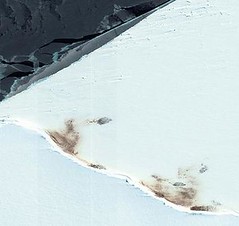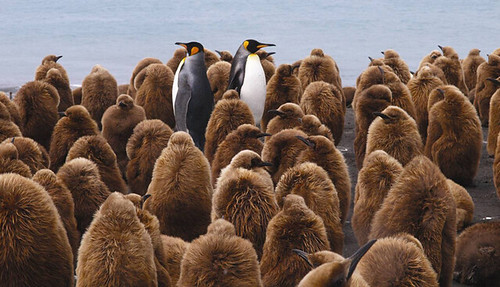 國際研究團隊13 日表示,首次從太空中計算特定物種族群數量的結果顯示,位在南極的帝王企鵝數量比原先估計的要多一倍。
國際研究團隊13 日表示,首次從太空中計算特定物種族群數量的結果顯示,位在南極的帝王企鵝數量比原先估計的要多一倍。
這項調查研究利用了高解析度人造衛星觀測技術,由英國南極考察隊、明尼蘇達大學/國家科學基金會、斯克里普斯海洋學研究所以及澳洲南極局等單位科學家共同執行。
團隊領導人英國南極考察隊的地理學家 Peter Fretwell 表示,這項研究成果極具開創性,因為他們提供了一個觀測企鵝如何受到環境變遷影響的基準。
研究成果發表在 14 日出刊的《PLoS ONE》期刊。科學家在論文中描述了使用超高解析度人造衛星影像推算南極海岸線每一個企鵝群聚數量的方法。
帝王企鵝是企鵝世界中的巨人,也是最大型的鳥類之一。黑白相間的帝王企鵝在雪地上很明顯,衛星影像可以輕易的分辨出牠們的群聚。
 利用全景銳化技術(pan-sharpening)增加衛星影像的解析度,科學家團隊可以分辨鳥類、冰雪、陰影以及鳥糞間的差別。然後再利用空照圖以及實地計數來校正分析的結果。
利用全景銳化技術(pan-sharpening)增加衛星影像的解析度,科學家團隊可以分辨鳥類、冰雪、陰影以及鳥糞間的差別。然後再利用空照圖以及實地計數來校正分析的結果。
研究團隊分析了南極海岸附近共 44 個帝王企鵝的群聚,包含 7 個原先未知的群聚。
帝王企鵝是所有企鵝中,唯一在南極冬季繁殖的種類,南極冬季溫度可低至攝氏負 50 度,風速則達每小時 200 公里。為了在南極的冬天生存,成年的帝王企鵝有特殊的適應 - 雙層的羽毛並囤積大量脂肪。
雌性企鵝生下一顆蛋後交給雄性進行孵育。蛋就放在雄企鵝的雙腳間,有厚厚的皮膚與羽毛,可以使企鵝蛋的溫度比外面的溫度高上攝氏 70 度。
然後雌企鵝就往海裏去找食物,並在小企鵝將孵化之際回來,接替雄企鵝的工作來養育小企鵝。此時雄企鵝已孵育企鵝蛋九周,喪失約 45% 的體重,然後會在冰雪中跋涉 100 公里尋找食物。當雄企鵝返回的時候,雙親會共同育雛。
科學家們憂心,部分的南極地區春季暖化時間提早,使得帝王企鵝的海冰棲地縮減,使得北邊的群聚在氣候變遷下更加脆弱。
研究的共同作者、英國南極考察隊生物學家 Phil Trathan 說,「這個研究顯示,南極企鵝群聚會受到氣候變遷極大的影響。對全南極大陸進行常態且容易施行的精準普查,可以幫助我們更準確的監測這類指標性物種未來的變化。」
「雖然目前的研究使我們預期帝王企鵝將在下個世紀大量減少,但暖化對南極的影響是區域性且不均勻的。」Trathan 說道,「未來較南部地區的群聚應該還會存續,使這些地方未來更具研究與保護的重要性。」
The first count of a species from space shows there are twice as many emperor penguins in Antarctica than previously thought, an international team of researchers revealed Friday.
Scientists from the British Antarctic Survey, University of Minnesota/National Science Foundation, Scripps Institution of Oceanography and the Australian Antarctic Division collaborated on the survey, using high-resolution satellite mapping technology.
Lead author and geographer Peter Fretwell at the British Antarctic Survey said the research findings are groundbreaking because they provide a benchmark for monitoring how the penguins are affected by environmental change.
The research is published today in the journal "PLoS ONE." In the article, the scientists describe how they used very high resolution satellite images to estimate the number of penguins at each colony around the Antarctic coastline.
The emperor is the giant of the penguin world and one of the largest of all birds. On the ice, black and white emperor penguins stand out against the snow and their colonies are clearly visible on satellite imagery.
Using a technique known as pan-sharpening to increase the resolution of the satellite imagery, the science teams were able to differentiate between birds, ice, shadow and guano. They then used ground counts and aerial photography to calibrate the analysis.
The team to analyzed 44 emperor penguin colonies around the coast of Antarctica, including seven colonies that were previously unknown.
Emperors are the only penguin species to breed through the Antarctic winter, with temperatures as low at -50°C and winds of up to 200km (124 miles) per hour. To survive the Antarctic winter, adult emperors have a special combination of adaptations, with a dense double layer of feathers and a large fat reserve.
The females each lay a single egg and pass it to the males for incubation. The eggs are balanced on the male penguins' feet, which are then covered by a thick roll of skin and feathers, which keeps the egg some 70°C warmer than the outside temperature.
The females then go to sea to feed, and return around the time when the chicks are due to hatch. The females then take over brooding and feeding the chicks whilst the males, after a nine-week fast during which they may lose 45 percent of their body weight, trek up to 100 km (60 miles) over the ice to find food. When they return, both adults rear the chick.
Scientists are concerned that in some regions of Antarctica, earlier spring warming is leading to loss of sea ice habitat for emperor penguins, making their northerly colonies more vulnerable to further climate change.
Study co-author British Antarctic Survey biologist Phil Trathan said, "Current research suggests that emperor penguin colonies will be seriously affected by climate change. An accurate continent-wide census that can be easily repeated on a regular basis will help us monitor more accurately the impacts of future change on this iconic species."
"Whilst current research leads us to expect important declines in the number of emperor penguins over the next century, the effects of warming around Antarctica are regional and uneven," Trathan said. "In the future we anticipate that the more southerly colonies should remain, making these important sites for further research and protection."






